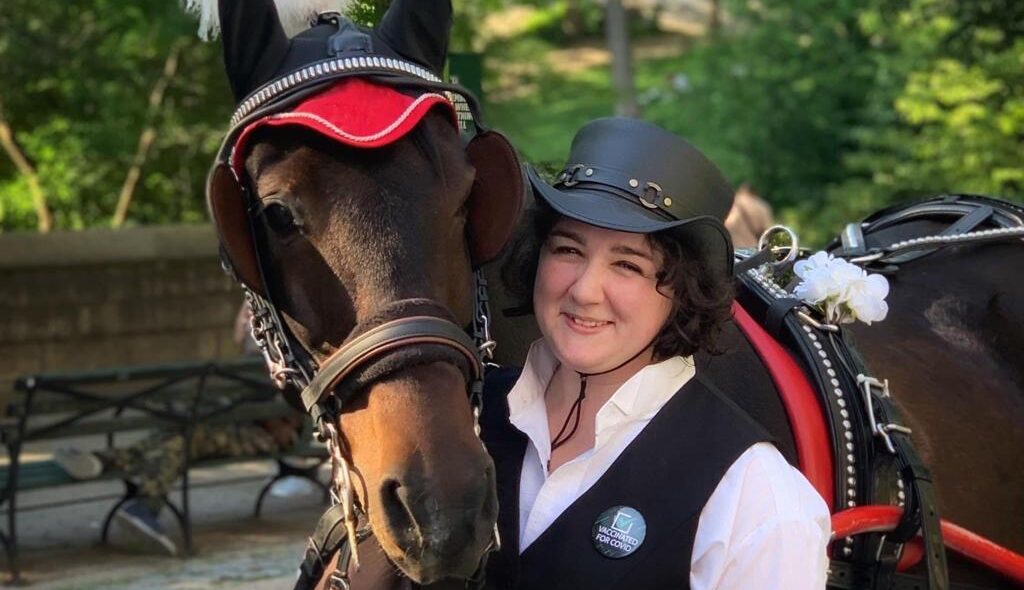Horse Breeds You Will See in Central Park

The Begian Draft

The Belgian draft horse originated in Belgium and is noted for its size and strength. Belgian drafts are believed to be descendants of the powerful and towering horses that carried knights into battle during medieval times.
Throughout much of history, Belgian drafts have been used in agriculture, logging, and hauling heavy loads of goods and materials. In addition to those traditional roles, Belgians today are engaged in riding classes, horse shows, strength competitions, recreational driving, carriage rides in the tourism industry and recreational carriage driving.
Draft horses by definition are large breeds, heavier and taller than others. The Clydesdale (seen on the Budweiser commercials) is a famous type of draft horse. Other types include the Percheron, the Shire and the Fresian.
The tallest horses on record were Belgian Drafts – Sampson and Big Jake.
Sampson, born in England in 1846, stood at approximately 21 hands, which is 7 feet tall. Big Jake, born in Nebraska in 2001, was approximately 6-feet-9 inches tall.

Breed Overview: Belgian Draft
Type: Draft
Origins: Belgium
Average Height: 16 to 18 hands (5-foot-3 to 6 feet tall)
Average Weight: 1,800 to 2,400 pounds
Physical Characteristics:
Common Colors: reddish brown, blonde manes and tale, white markings on face and legs.
Common Uses: plowing, logging, pulling carriages, recreational riding and jumping.
The Morgan

One of the first horses developed in the United States, the Morgan breed is known for speed, strength, and versatility. It gained great popularity as an all-purpose horse and played a significant role in post-colonial America, working on farms, bringing families to town in buggies, and racing in both saddle and harness.
The Morgan was widely used as a calvary horse in the Civil War. Union soldiers in the Fifth NY Calvary Company, which was at 175 skirmishes and battles, including Gettysburg, rode Morgan horse.
Morgan horses are all descendants of a colt that was born in 1789 in Springfield, Mass., that was owned by Justin Morgan, a teacher, composer, and horse breeder.

Breed Overview: The Morgan
Average Height: 14 hands to 15 hands (4-foot-6 inches to 5-feet tall)
Average Weight: 1,000 pounds
Physical Characteristics:
Common Colors: bay, black, brown, or chestnut
Common Uses: pleasure riding, ranch work, trail riding, dressage, cross-country and show jumping, carriage rides
The Percheron

The exact origins of the Percheron are not known but it was present in a former province of France, La Perche, by the 17th Century. It’s believed their ancestors carried knights into battle during the Middle Ages. Their lineage may include Arabian horses brought back to France from the Middle East during those crusades. They were later used by the French Calvary in the 1800s.
Over over the ensuing centuries, Percherons pulled stagecoaches, plowed fields, and transported goods and materials in large carts. Today, Percherons are most often used for hayrides, pulling sleighs and carriages, plowing fields for Amish farmers and others using traditional pre-engine methods, recreational riding, horse shows and carriage rides.

Breed Overview: Percheron
Origins: France
Average Height: 15 hands (60 inches) to 19 hands (76 inches)
Average Weight: 1,800 to 2,600 pounds
Physical Characteristics:
Common Colors: gray, black, chestnut
Common Uses: pulling hayrides, sleighs, carriages, farming, recreational riding, horse shows.
Saddlebred

The Saddlebred combines stamina with a graceful flair with features that include a high-step and a long, sloping neck. Perhaps that’s why the Saddlebred was the mount of choice for the highest-ranking generals and officers on both sides of the Civil War, although it was then called the Kentucky Saddler. General Ulysses S. Grant’s horse was Cincinnati. General Robert E. Lee rode Traveller.
The Saddlebred’s origins trace back to the 1700s when colonials crossed imported English Thoroughbreds with the first American breed – the Narraganset Pacer, which was known for its ability to travel long distances at moderate pace. There are carriage horses in the park that are combinations of the Standardbred and a draft like the Belgian or Percheron.

The Standardbred is a relatively newcomer on the world stage. It’s only been around for about 230 years, making the breed about the same age as the United States. It was developed in the late 18th Century from a variety of breeds starting with an English Thoroughbred, Messenger, that was imported to America from England in 1788. His descendants were bred with other types of horses, including the Morgan and the Hackney.
Standardbreds are known for their stamina and ability to race in harness (harness racing). Harness racing requires horses use one of two prescribed and controlled gaits: the pace or trot. In the pace, the front and rear legs move forwards in pairs. In the trot, the front and rear legs move together in diagonal pairs. (link) Many of the Standardbreds in Central Park previously were owned by Amish families that shun car ownership and opt to largely live without modern technology.

Breed Overview: Standardbred
Origins: United States
Average Height: 14 to 17 hands (4-foot-6 inches to 5-foot-6 inches)
Average Weight: 800 to 1,000 pounds
Physical Characteristics:
Common Colors: bay, brown, black, chestnut, gray
Common Uses: harness racing, recreational riding, horse shows, Amish buggies, carriage rides